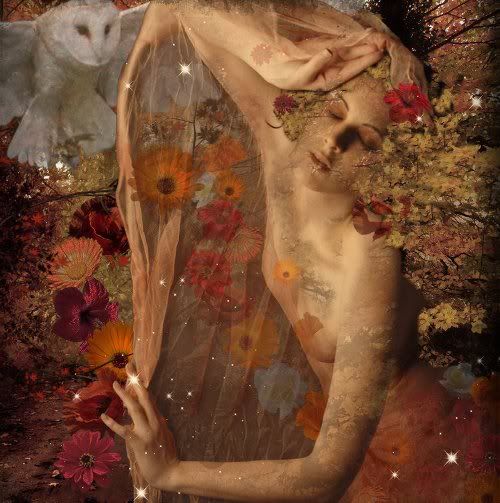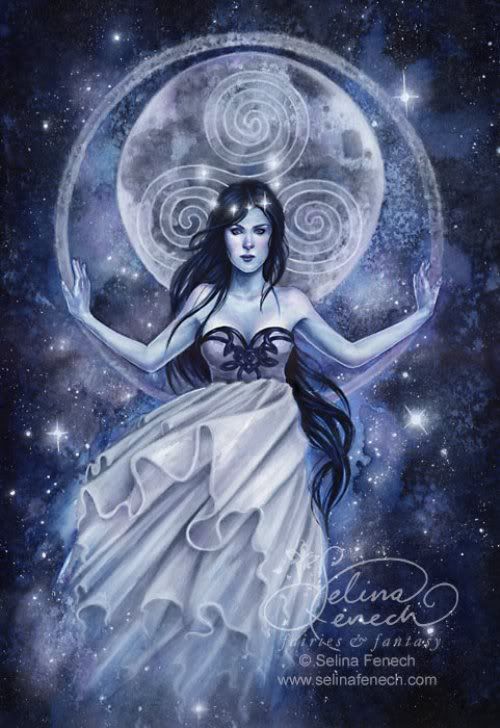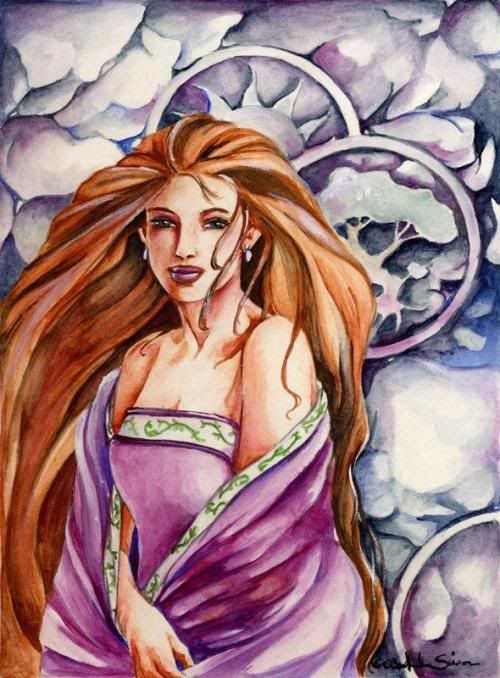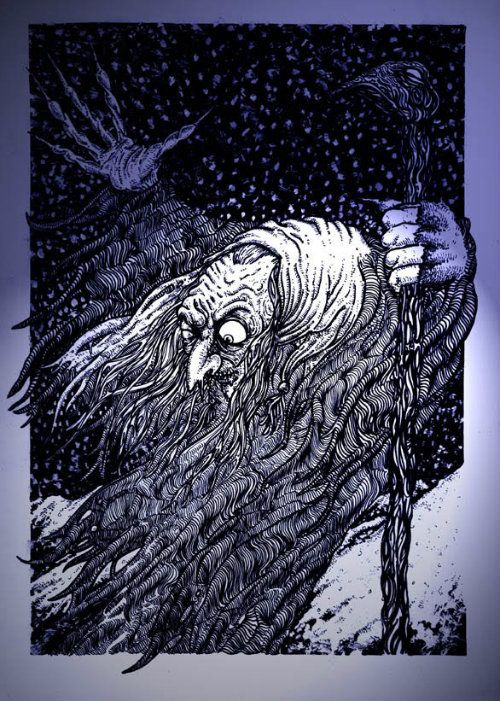
The Altar of the Arcane Song celebrates its chosen Matrons and Patrons of the Celtic and Native American Pantheons. My Soul-Sister Selene and I met a small conundrum when it came to shared ritual. I work solely with the Slavic pantheon while she works with the Sumerian one.
Together we agreed that because our Shrine falls under the imperium of the Temple of the Celtic Cross, which in turn falls under the imperium of the Correllian Nativist Wicca Tradition, and there are both Celtic and Native Deities to whom we are drawn, that we would work with the Celtic and Native American pantheons in our Shine as we share in ritual together before the Altar.
The chosen Matrons of the Altar of the Arcane Song are Blodeuwedd, Arianrhod, Danu, Cailleach, Sedna and Grandmother Spider. The Patrons of the Altar are The Green Knight, Lugh, and The Dagda. You can merry meet with all of them below!
Altogether they are a collective of two maiden goddesses, two mothers, two crones, and one Youth, one King and one Sage. Serendipitously and synergetically they are nine deities in all, and as nine is the number sacred to primordial Goddess, we can't think of anything that is more pure perfection than this. As Selene says there are no coincidences. Blessed be!
Faemore
Brighid
Blodeuwedd

Blodeuwedd, maiden Goddess of the Owl
Blodeuwedd is the Welsh Goddess of Spring. She was created from the flowers of the Oak, the Broom and Meadowsweet, by the magician, hero and trickster Gywdion, uncle of Lleu, the Welsh equivalent of the Shrine's own Lugh, and brother of Arianrhod. Due to the nature of Her birth, Blodeuwedd, whose name means “Flower Face” - the ancient name for Owl - represents the mythic, maiden Earth in full bloom. Blodeuwedd was created for the purpose of another - to be Lleu’s wife - and it is due to these circumstances of Her birth, that Her actions may be seen in a more sympathetic light. She was created from the flowers of a very powerful tree - the oak - flowers of a clearly healing nature in order to give power to Lleu, to continually heal and renew him and to assure his right to rule the land. She was never asked whether She loved him or desired to marry him. She was never asked anything at all.
One day, when Blodeuwedd was left alone with Her ladies in the castle, it chanced that a stag hunt passed and was spotted near by. Blodeuwedd, sends a messenger offering the party hospitality for the night. As soon as she meets and beholds its leader, a young huntsman who seeks shelter, She deeply experiences love at first sight. Wanting nothing more than to be with him, Blodeuwedd seeks to discover the improbably circumstances surrounding Lleu’s death, that She may kill him, for Her own desire is impossible to attain while he lives. She feigns anxiety concerning him meeting his untimely death one day, and eventually Her pleading to show Her that he could not be easily slain and that his death could not be easily accomplished, persuades Lleu to demonstrate the very circumstances that would lead to it.
Blodeuwedd takes flight across the night sky and away from Gwydion, who turns her into an Owl as punishment for the death of Lleu, decreeing that she will never show her face again in the light of day. A path of white flowers springs up in her wake, which we know today as The Milky Way. Throughout Celtic legend otherworldly women are created and used to represent the Land, which is definitely feminine in nature. Owl, the totemic representation of Blodeuwedd, signifies the complete transformation of the initiate. She is a Goddess of emotions, representing the matrix that reforms universal and transpersonal energies into well-defined life force. Blodeuwedd is also the Maiden Goddess of initiation ceremonies and is also known as the Ninefold Goddess of the Western Isles of Paradise. Flowers, the wisdom of innocence, Lunar Mysteries and initiation are Her provinces.

The story of Blodeuwedd is one choice. We are who we make ourselves. We may be fashioned from certain elements by certain elements, and those who create us may have the finest intentions, but in the end - we are the ones who choose our path. Blodeuwedd is the blossoming Earth Goddess of the summer, She is the sovereign Goddess of the land, whom the Sacred King must marry if he is to rule. Her two lovers are seasonal Gods or annual Sacred Kings, rivals for her hand. She is betrothed at Beltane, falls in love with another at Litha and is transformed for it at Lughnasadh.
Blodeuwedd is the youthful maiden goddess of summer. She indicates blossoming and flowering, growth and expansion. She is the goddess of becoming, of the self realisation that cannot come through another, but only through the paradox of realising that you are individuated and unique, yet a part of the greater whole. Though she was created by a man to become the bride of another, she rebelled against the role chosen for her, and far from being a pawn created to serve them, Blodeuwedd is a source of power, the earth goddess. Her two lovers represent summer and winter who must battle for her hand at the equinoxes.
Blodeuwedd was magickally conjured by Gywdion from the essence of flowers. Among other floral essences Meadowsweet, broom flower and oak were used to create her magnificence. Meadowsweet symbolises grace, refinement and elegance. Broom flower, to form her beauty, is attributed with energy, vitality and warmth and lastly oak, to make her lovelier than any other, has the quality of integrity, honesty and truth. Blodeuwedd above all had the integrity to reach for her purpose and place in a world which would dictate them for her. She was honest about feelings and her heart. She was true to herself.

Blodeuwedd is the maiden goddess of the Owl, elusive creature of the night. In the parable of Blodeuwedd the Owl is symbolic of transformation and darkness. She is nocturnal and a symbol of the night and all things that come alive under the cloak of darkness.
Owl expands vision, allowing one to see the landscape of one’s life with new eyes. The moral of Blodeuwedd is that sometimes darkness can reveal more than light. We all have seasons of bright blooming, but we each must sail the night sky for perspective as well. Owl is symbolic of that transition from one perspective to another. Blodeuwedd is the Welsh word for Owl.
She is the white maiden Goddess of Life and Death in Her May-aspect and part of a triad consisting of Arianrhod, the red mother, and Cerridwen, the black crone. Blodeuwedd represents temporary beauty and the bright blooming that must come full circle through death: She is the promise of autumn visible in spring. She is enchanting.
Faemore
Arianrhod

Arianrhod, mother Goddess of the Moon and Stars
Arianrhod is the Celtic Moon-Mother Goddess. She derives her name from the Milky Way, the zodiac and the moon. Her name means Silver Wheel, Arian meaning Silver, and Rhod meaning Wheel. She is called the Silver Wheel that Descends into the Sea. Arianrhod is the mistress of Caer Sidi, a magickal realm in the north, depicted as a great, turning island surrounded by Sea, where she was worshipped as priestess of the moon. She is the beloved silver sky-lady coming down from the firmament in her pale, white chariot, to watch more closely over the tides she rules.
A star and moon goddess, Arianrhod was also called the Silver Wheel because the dead were carried on her Oar Wheel to Emania, the moon-land or land of death, which belonged to her as a deity of reincarnation, karma, weaving, cosmic time and fate. She is the mother aspect of the triple goddess, and is therefore honoured at the time of the full moon. The palace of Arianrhod is Caer Arianrhod, the Aurora Borealis, the revolving castle that spins and swirls and spirals, the secret center of each initiate's spiritual being, which souls withdraw to between incarnations.
The moon, the archetypal female symbol, represents the Mother Goddess, connects the womb, death, rebirth and creation. Her position in the night sky and progress in relation to the stars is known as the starry wheel of Arianrhod. Arianrhod is signified by silver, wheels, stars, nets, webs, owls and the full moon. She is a Goddess of Beauty, who weaves peoples' lives, past and present, into the fabric of the afterlife, sending them onto other realms or returning them for another life. Arianrhod's sacred plant is ivy, and spiders are also associated with her, for she is seen as a weaver of fate.
Arianrhod is the center around which the universe wheels. Arianrhod is the goddess of the Wheeling Stars. She is a celestial goddess, imaging spiral movement around a central star or spark, in the turning of the labyrinth and its inhabitant. She signifies the still point in the middle of motion, the paradoxical position at the center of the wheel where one is moving yet still.
Arianrhod is able to shapeshift into a large Owl, and through her great Owl-eyes, sees even into the darkness of the human subconscious and soul. Owl symbolises death and renewal, wisdom, magick and initiations. She moves with strength and purpose through the night, her wings of comfort and healing spread to give solace to those who seek her, and she is Faemore's totem!
Arianrhod's festival is celebrated on the 2nd of December.
Faemore

Arianrhod, Lady of the Silver Wheel
Danu

Danu, ancestral Mother Goddess of the Ancient Celts

Cerridwen

Cerridwen, the Celtic Goddess of Rebirth
Cerridwen is the Celtic Goddess of rebirth, transformation and inspiration. She is an enchantress, a sorceress, who possesses the Cauldron of Wisdom and Knowledge. Cerridwen is one of the Old Ones, one of the great megalithic Goddesses of the Celtic World. Although, in her story, she embodies all three lunar aspects of the Goddess - Maiden, Mother and Crone - she is primarily honoured in her aspect as the Dark Lady, and through her cauldron of destruction and creation, transformation and rebirth.
Cerridwen is the Celtic Goddess of rebirth, transformation and inspiration. She is an enchantress, a sorceress, who possesses the Cauldron of Wisdom and Knowledge. Cerridwen is one of the Old Ones, one of the great megalithic Goddesses of the Celtic World. Although, in her story, she embodies all three lunar aspects of the Goddess - Maiden, Mother and Crone - she is primarily honoured in her aspect as the Dark Lady, and through her cauldron of destruction and creation, transformation and rebirth.
The cauldron has an intimate connection with femininity, together
with the cave, the cup, the chalice and the mortar, and the correspondence of
femininity with inspiration, karma and metamorphosis, harkening back to very
ancient times. Cerridwen's cauldron is an ancient feminine symbol of renewal,
rebirth, transformation and inexhaustible plenty. It is the primordial feminine
symbol of the pagan world, and symbolises the womb of the great Goddess, from
which all things are born and reborn again.
The symbol of Cerridwen's Cauldron is the mythical origin of the
Halloween image of the cauldron-stirring hag, concocting her witch's brew. In
Cerridwen's mythos her brew had to simmer for a year and a day, a common
passage of time in Celtic lore, and the traditional length of time before
magickal initiation. Cerridwen's power to transform symbolises the different
degrees of Druidic initiation rites, as well as the many changes our souls must
make into different human forms, and over different human lifetimes, to
experience and to learn, to evolve and to return; to exist. The potent nature of her Cauldron's brew has
transformed Cerridwen herself into a Goddess of fertility and harvest,
creativity and luck.
The story of Cerridwen is a metaphor for the
teacher and the student. Cerridwen is The Teacher, and we are the Student. She
challenges us, when we are ready. Her witch's brew is knowledge, which, when we
drink it, runs through us like wild fire, exploding with sudden meaning.
Cerridwen forces us to acquire new wisdom, forces us to use the knowledge we
acquire. In the end she devours us, to bestow upon us a new and greater
identity. Thus we are initiated into the mysteries.
Transformation is an integral part of Cerridwen's
mythology, and at the center of this mythical element is the cauldron. In the
Celtic Mystery Tradition, there are three types of cauldrons. The Cauldron of
Transformation, the Cauldron of Rebirth and the Cauldron of Inspiration.
Cerridwen's cauldron symbolises the merging together of all three of these mythical
elements into one archetypal cauldron. The Celtic afterworld is called The Land
of Youth, and the secret to opening its doors is found in Cerridwen's Cauldron.
The secret in immortality lies in seeing death as an integral part of life, and
that every death brings rebirth, and that every ending brings beginning.
Cerridwen's witch's brew symbolises greatness and inspiration. It is an encryption of primeval creative power. It transforms us several times, and we are reborn in human form to assimilate the knowledge we already possess. The ancient cauldron of the Goddess Cerridwen is a symbol of enlightenment and spiritual transformation.
Cerridwen's witch's brew symbolises greatness and inspiration. It is an encryption of primeval creative power. It transforms us several times, and we are reborn in human form to assimilate the knowledge we already possess. The ancient cauldron of the Goddess Cerridwen is a symbol of enlightenment and spiritual transformation.
Cerridwen is a crafty one, keeping her cauldron
of inspiration. She is called the "Sacred Lady of Inspiration and
Death", ritualistically pursuing us, symbolised by the changing of the
seasons. The brew contained in her cauldron is called awen, the Divine Spirit, and it
is pure poetic and prophetic inspiration. However, Cerridwen as the Mother of
Poetry, signifies chaotic inspiration, the kind that knocks plans off course,
changes projects and shapes a person according to their true will.
Cerridwen is a Nature Goddess. She lived on an
island in a lake, just as Mother Earth exists as an island in the sky. Like
Mother Earth, the Goddess Cerridwen is beautiful and reminds us that we all
come from that beauty. As women we are born of Her blood, beautiful in Her
image and blessed with all the magick and wisdom of Her cauldron. When we turn
to Her, our light grows and becomes empowered, transforming us into sacred
beings, and the Sacred Lady, Goddess.
Faemore

Cerridwen, Sacred Lady of Inspiration and Death.
Cailleach

Cailleach, creatrix Crone Goddess
Cailleach is the divine hag, the creatrix crone, and the ancestral goddess of Scottish mythology. Also known as Cailleach Bheur and Beira, Queen of Winter, she made the mountains and hills, forming them from rocks dropped from her apron when she strode across the land. They are her stepping stones. She carries a hammer for shaping those hills and their valleys. She is the mother of all goddesses and gods.
The Cailleach, as a seasonal deity, is the personification of Winter itself: she herds deer and fights Spring. Her staff freezes the ground it strikes. Cailleach ushers in the winter by washing her great plaid kilt in the whirlpool of Coire Bhreacain. The cleansing takes three days, during which the roar of the coming Winter is heard inland, from far away. When it is finished, her plaid is pure white and snow covers the land.
The word Cailleach comes from the old Irish word caillech meaning 'Veiled One'. She is the Ancient Earth herself; the lichen-covered rocks and the mountain peaks. She is the bare earth covered with snow and frost.; the Deep Ancestress, veiled by the passage of time. Cailleach is the Goddess of Transformation, the one who watches over the culling of the old growth. She is the Death Goddess, who let's die what is no longer needed.
In the debris of the passing season she finds gems, the seeds for the season to come. She is the guardian of the seed, the keeper of the essential life force. She holds the power of life in her palm. She is the hag of Winter, oft portrayed as a grotesque giantess leaping from mountaintop to mountaintop. The rocks dropping from her apron become the hills.
Cailleach has a blue-black face with only one eye in the center of her forehead. Her teeth are red, and her hair is matted brushwood covered with frost. She wears grey clothes, and a great plaid is wrapped around her shoulders. When the winter storms rage through the hills, Cailleach is tramping her blankets. It is clear that the Cailleach is one with the land, clothes in the snow of winter, with brushwood growing on her body. Her one eye shows that she sees beyond duality to the ultimate unity of all things in the Web of Life.
In Celtic mythos and legend the hag is the Sovereignty of the land, and life. Fierce though the power might be, it dwells within us all. Cailleach gives us the wisdom to let go of what is no longer needed, and holds dear the seeds of what is yet to come, standing on the cusp of Life and Death.

Cailleach, The blue Hag-Goddess of Winter
Cailleach is the great unknowable, mysterious and terrifying. She is vastly ancient. The early Celts savoured the dark side of life. Darkness was associated with new beginnings, the potential of the seed below the ground. In Celtic mythology and folklore, the wisdom of darkness is often expressed by powerful goddess figures, whose role is to catalyze change through the transformative power of darkness, to lead through death into new life.
Cailleach is a Dark Goddess of Nature, belonging to hidden worlds. She is the divine Old Woman, a deity who is both transcendent and immanent. She personifies the cutting winds and harshness of the northern winter. She is the guardian spirit of the Owl, the Deer, the Cat and the Wolf; connected with lakes, wells, marshes, seas and storms; with boulders, rocks, mountains, megalithic temples and standing stones, and with owls, wolves, cats, deer and trees. She is the Old Wife of Thunder.
The Cailleach rambles the hills followed by troops of wild deer, as she leaps from hilltop to hilltop. She created the mountains and lakes, and birthed the archaic cairns and megaliths. She is a tremendous mythic figure, the elemental power of winter, of the cold, the wind and tempests. She comes into power as the days shorten and the sun courses low in the skies. Along with her hammer, she carries a slachdan (a wand of power) with which she shapes the land and controls the weather. She strikes the ground with it, making the earth harden with frost. Wherever the Cailleach throws her slachdan, nothing grows.
Cailleach hurls her slachdan into the root of the holly and gorse, plants symbolic of winter, and sacred to her, storing the power of the cold and the dark there until the advent of winter. During the light half of the year she metamorphoses into a grey boulder, always moist, because it contains the substance of life. She is the Old Goddess that sits on the rocks, looking out to sea, her face the blue black lustre of coal, her bone-tufted teeth the red of rust, in her head one pool-like eye, swifter than a star in the wintry skies.
Cailleach existed from the long eternity of the world. She is a being of immense antiquity who is able to renew her vitality in wells of virtue and who outlasts generations of her offspring. Her age is revered. Cailleach is the shaper of the world. In many places standing stones are said to be people and animals that she transformed. She is the spirit of the wilderness and the protector of wild animals. She is the old woman who ranges the mountains and glens.
As the days grow shorter and autumn turns to winter, cold winds, the breath of the Cailleach, the blue hag-goddess of winter, scour the land. Her association with stone and the cairns and the mounds reveals her connection with the underworld and ancestral realms, with death and rebirth. The Owl, also associated with death, the underworld, magick and the ability to see spirits, is sacred to her.
The Cailleach's great age signifies her position as keeper of the mysteries, and as gateway to the infinite. She holds the seeds of the new, warm and safe in her lap beneath the earth, hinting of the new life that will eventually come after the long sleep that is winter. Peer into the darkness to find the old and ancient bones. What do they cage? What new thing can they support? Is the Cailleach holding beautiful Spring captive, or will time transform the Hag into Spring Herself? Hail the Cailleach! Ancestral Hag of Winter. Unveil yourself before us, that we may see the worlds.
Faemore

Cailleach, The Divine Ancestral Hag
The Greenman

The Greenman, youthful Lover God
Lugh

Lugh, heroic King God
The Dagda

The Dagda, fatherly Sorcerer God and protector of the Shrine
Thank you for keeping us aware of the magick and the mystery, the joy of the wonder of each day and of all life. Because of you we walk our path without fear. Blessed be!
Brightly-spun breezes,
Faemore Lorei and Selene Lilitu
No comments:
Post a Comment
Note: Only a member of this blog may post a comment.